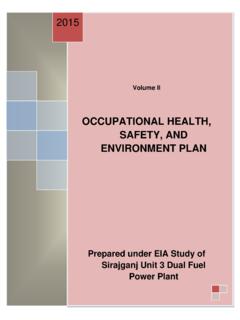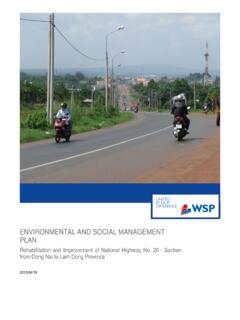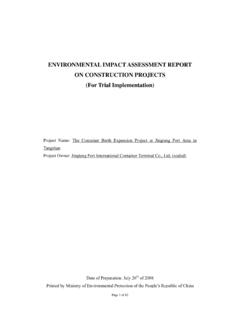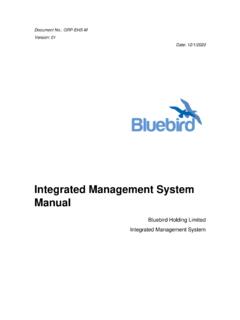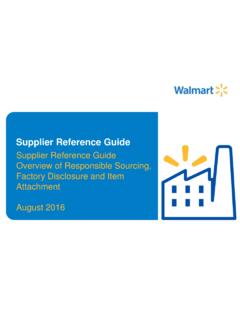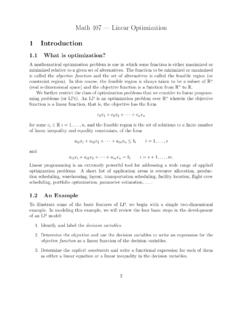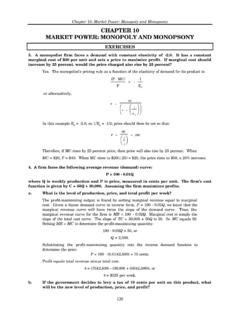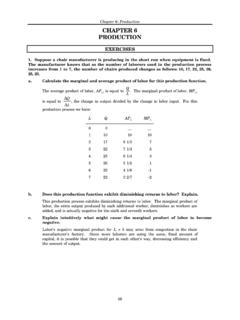Transcription of ENVIRONMENT IMPACT ASSESSMENT REPORT
1 RWANDA STONES & CONSTRUCTION (RSC) Ltd Co August 2011 EENNVVIIRROONNMMEENNTTAALL IIMMPPAACCTT AASSSSEESSSSMMEENNTT ((EEIIAA)) RREEPPOORRTT FFOORR AA SSTTOONNEE CCRRUUSSHHIINNGG FFAACCTTOORRYY 2 Contents EXECUTIVE SUMMARY .. 4 2. INTRODUCTION .. 6 Author Presentation .. 6 Promoter Presentation .. 6 Objectives of the study .. 7 Methodology used for the study .. 8 3. LEGISLATIVE AND REGULATORY CONSIDERATIONS .. 10 Legislative and policy framework for environmental IMPACT ASSESSMENT (EIA) in Rwanda .. 10 The Constitution of the Republic of Rwanda .. 10 Rwanda Vision 2020 .. 10 Economic Development and Poverty Reduction Strategy (EDPRS) .. 10 The National Environmental Policy .. 11 The National Environmental Law .. 11 Institutional framework for environmental management in Rwanda .. 13 International legislative framework .. 13 Environmental Standards.
2 15 4. BASELINE DATA .. 16 General description of the NYABIGUGU site area .. 16 Bio-physical ENVIRONMENT .. 17 Physical ENVIRONMENT .. 17 Biological ENVIRONMENT .. 18 Socio-economical ENVIRONMENT .. 18 5. PROJECT DESCRIPTION NYABIGUGU Site .. 18 Project size .. 18 7. EVALUATION OF IMPACTS .. 25 NYABIGUGU Sites Kicukiro District .. 25 Impacts classification .. 26 Identification of Potential Impacts of the project .. 26 Potential Positive Impacts of the project .. 27 Potential Negative Impacts of the project .. 27 Evaluation and analysis of the projects impacts .. 28 Impacts on the human ENVIRONMENT .. 28 Impacts on the biophysical ENVIRONMENT .. 29 Analysis of alternatives .. 30 9. MITIGATION MEASURES .. 30 Air pollution .. 30 Human waste management .. 31 Mitigation measures for solid waste .. 32 Measures to avoid road and on site accidents .. 32 10. ENVIRONMENTAL MANAGEMENT PLAN (EMP) .. 35 Detailed description of the modalities to implement the proposed mitigations measures.
3 36 11. CONCLUSION AND RECOMMENDATIONS .. 40 It is concluded that; .. 40 Recommendations .. 40 REFERENCES .. 41 3 APPENDICES .. 42 4 EXECUTIVE SUMMARY The article 67 of the Organic Law N 04/2005 of 08/04/2005 determining the modalities of protection, conservation and promotion of ENVIRONMENT in Rwanda stipulates that every development project shall be required to undergo Environmental IMPACT ASSESSMENT prior to its commencement. Furthermore the Ministerial order No. 004/2008 of 15/08/2008 establishing the list of works, activities and projects that have to undertake an environmental IMPACT ASSESSMENT lists construction of industries, factories and activities carried out in those industries . It this regards that RWANDA STONES & CONSTRUCTION (RSC) Ltd Co hired the consultancy firm, Green World Consult, to carry out the present Environmental IMPACT ASSESSMENT .
4 The identification of the impacts of the project on the ENVIRONMENT showed that during the operation, there will be no negative IMPACT on ENVIRONMENT as it is a stone crushing factory which does not use any chemicals. The stones are dry and hence no effluent. The type of rock to be crushed is very hard black type with specialized equipment and therefore minimal emissions is expected to be released to the atmosphere. There will be an important number of positive impacts on the human ENVIRONMENT such as availability of stone to supply the exponentially growing construction industry in Rwanda and East Africa at large, the improved employment opportunities to the population of the zone, the increase in the income of the population working on the site, the payment of taxes to the local and central government as well contributing then to the poverty reduction in the country in general.
5 The project will also have some marginal negative impacts especially during the crushing process such as production of dust emissions and noise pollution; on the socio-economical and biophysical ENVIRONMENT such as the degradation of air quality by the dust emitted during the site clearing, effects of air pollution, risk of excess soil being eroded from the site where stones are manually extracted, Loss of habitat for some fauna and flora species and biodiversity reduction due to vegetation clearing neighbouring the stone extraction site. 5 Different mitigation measures for these negative impacts have been proposed to reduce to the minimum their effects on the socio-economical ENVIRONMENT as well as on the biophysical ENVIRONMENT . Among the proposed mitigation measures are to use specialized equipment and have them serviced regularly so as to minimize noise and dust emissions, good site management system is proposed in order to minimize the risk of accidents during the process of crushing.
6 An ecosan toilet to be installed to prevent pollution from human waste. In order to ensure that the proposed mitigation measures will be implemented, an environmental management plan has been developed to guide all activities of the project during all its phases concerning the protection of the ENVIRONMENT . This plan specifies the nature of the negative IMPACT , the proposed mitigation measures, the indicators in the execution of these mitigation measures, the time period, the responsibilities and the follow-up needed from concerned and specified parties. An emergency plan in case of accident was also developed. Some negative impacts of this project can be eliminated, reduced or compensated if the proposed environmental management plan is followed as proposed. Additional to that some recommendations have been proposed so that the execution of the project becomes a success without harming or with the least negative effect to the ENVIRONMENT in general.
7 6 2. INTRODUCTION Stone crushing industry is an important industry sector in the country engaged in producing crushed stone of various sizes depending upon the requirement which act as raw material for various construction activities such as road construction, bridges, highways among others. The stone crushing plant employs many people both skilled and unskilled who are involved in the entire process of mining, crushing and transportation of the crushed stone. The plant s ideal location is supposed to be near growing towns or cities so as to supply the demand for the stone and at the same time near the source to the stone to be crushed. Rwanda Stones & Construction Ltd will produce and sell all types and grades of gravel to public and private customers based all over the country and mainly in Kigali City. The site of 8,719 square meters is called NYABIGUGU site and is located in Kicuciro district, Gahanga sector, Murinja cell.
8 This Study consists in assessing the Environmental Impacts for the project of crushing stone in the site mentioned above. Author Presentation This REPORT has been produced by Green World Consultants that was hired by the Project Promoter, Rwanda Stones & Construction Ltd Co, to carry out the study. The Consultancy firm is based in Rwanda and has got strong background and knowledge in the area of Environmental ASSESSMENT , and a track record of over 8 years for conducting studies of Environmental IMPACT ASSESSMENT for Development Projects in Africa in general and particularly in Rwanda. Promoter Presentation The Rwanda Stones and Construction Ltd Co. is owned by Mr. RATHOD RAYSANG GANDABHAI and Indian national who holds 50% of the capital and has an extensive experience in all phases of gravel and rock hauling , production and industrial practices who will oversee operations of the company.
9 The second share holder is 7 Mr. HERMAN PURSOTTAMBAHAI also an Indian national who holds 50% of the capital educated in natural resources management and with customer service experience, shall be in charge of public accounts and day to day management. Objectives of the study Reducing the burden of environmental impacts is necessary if development is to become sustainable. As resources become limited, environmental impacts become more complex, EIA has become of ever increasing importance as a tool for development and decision making. This role is formally recognized in principle 17 of the Rio Declaration on ENVIRONMENT and Development (UNCED 1992). Environmental IMPACT ASSESSMENT , as a national instrument, shall be undertaken for proposed activities that are likely to have significant adverse IMPACT on the ENVIRONMENT and are subject to a decision of a competent national authority.
10 In practice, EIA is applied primarily to prevent or minimize the adverse effects of major development projects. It is also used as a planning tool to promote sustainable development by integrating environmental considerations into a wide range of proposed actions. Most notably, the use of policies and plans to focus on the highest levels of decision making and take care of the ENVIRONMENT in considering development alternatives and options. More limited forms of EIA can be used to ensure that smaller scale projects like the Rwanda Stone and Construction Co; conform to appropriate environmental standards or site and design criteria. The aim and objective of EIA can be divided into two categories. The immediate aim of EIA is to inform the process of decision making by identifying the potentially significant environmental effects and risks of development projects.




